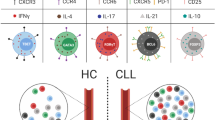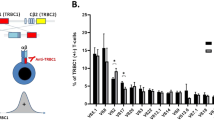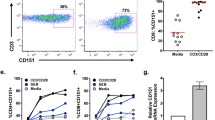Abstract
Patients with chronic lymphocytic leukemia (CLL) have defects in both cellular and humoral immunity. Since CD152 (CTLA-4) plays a critical role in downregulating T-cell responses, we studied the expression of surface and cytoplasmic CD152 (sCD152 and cCD152, respectively) in freshly isolated T cells from treatment-naïve patients with CLL. CD4+ and CD8+ T cells from these patients demonstrated significantly increased sCD152 and cCD152 compared to normal donors. Furthermore, these patients had an increased proportion of the regulatory CD4+/CD25+/CD152+ subset that correlated with advanced Rai stage, unfavorable cytogenetics and low serum IgG and IgA levels. The expression of sCD152 by T cells also correlated with ZAP-70 expression by CLL B cells. The proportion of CD4+/CD25+ cells was also correlated with unmutated immunoglobulin heavy chain variable gene status. Blockade of CD152 with monoclonal antibody (mAb) in proliferation assays was associated with potent T-cell proliferation in response to autologous and allogeneic CD40-activated CLL B cells. In summary, T cells from patients with CLL may be primed for anergy by expressing increased amounts of CD152; anti-CD152 mAb may represent a therapeutic opportunity to enhance an immune response against autologous leukemia cells.
This is a preview of subscription content, access via your institution
Access options
Subscribe to this journal
Receive 12 print issues and online access
$259.00 per year
only $21.58 per issue
Buy this article
- Purchase on Springer Link
- Instant access to full article PDF
Prices may be subject to local taxes which are calculated during checkout



Similar content being viewed by others
References
Matutes E, Wechsler A, Gomez R, Cherchi M, Catovsky D . Unusual T-cell phenotype in advanced B-chronic lymphocytyc leukemia. Br J Haematol 1981; 49: 635–642.
Pavkovic M, Georgievski B, Cevreska L, Spiroski M, Efremov DG . CTLA-4 exon 1 polymorphism in patients with autoimmune blood disorders. Am J Hematol 2003; 72: 147–149.
Cinek T, Sandra A, Imboden JB . Cutting edge: tyrosine-independent transmission of inhibitory signals by CTLA-4. J Immunol 2000; 164: 5–8.
Kuiper HM, Brouwer M, Linsley PS, Van Lier RAW . Activated T cells can induce high levels of CTLA-4 expression on B cells. J Immunol 1995; 155: 1776–1783.
Magistrelli G, Jeannin P, Herbault N, Benoit de Coignac A, Gauchat JF, Bonnefoy JY et al. A soluble form of CTLA-4 generated by alternative splicing is expressed by nonstimulated human T cells. Eur J Immunol 1999; 29: 3596–3602.
Rossi E, Matutes E, Morilla R, Owusu-Ankomah K, Heffernan AM, Catovsky D . Zeta chain and CD28 are poorly expressed on T lymphocytes from chronic lymphocytic leukemia. Leukemia 1996; 10: 494–497.
Van den Hove LE, Van Gool SW, Vandeberghe P, Bakkus M, Thielemans K, Boogaerts MA et al. CD40 triggering of chronic lymphocytic leukemia B cells results in efficient alloantigen presentation and cytotoxic T lymphocyte induction by up-regulation of CD80 and CD86 costimulatory molecules. Leukemia 1997; 11: 572–580.
Scrivener S, Kaminski ER, Demaine A, Prentice AG . Analysis of the expression of critical activation/interaction markers on peripheral blood T cells in B-cell chronic lymphocytic leukaemia: evidence of immune dysregulation. Br J Haematol 2001; 112: 959–964.
Frydecka I, Kosmaczewska A, Bocko D, Ciszak L, Wolowiec D, Kuliczkowski K et al. Alterations of the expression of T-cell-related costimulatory CD28 and downregulatory CD152 (CTLA-4) molecules in patients with B-cell chronic lymphocytic leukemia. Br J Cancer 2004; 90: 2042–2048.
Read S, Malmstrom V, Powrie F . Cytotoxic T lymphocyte-associated antigen 4 plays an essential role in the function of CD25+CD4+ regulatory cells that control intestinal inflammation. J Exp Med 2000; 192: 295–302.
Takahashi T, Tagami T, Yamazaki S, Uede T, Shimizu J, Sakaguchi N et al. Immunologic self-tolerance maintained by CD25+CD4+ regulatory T cells constitutively expressing cytotoxic T lymphocyte-associated antigen 4. J Exp Med 2000; 192: 303–310.
Baecher-Allan C, Brown JA, Freeman GJ, Hafler DA . CD4+ CD25high regulatory cells in human peripheral blood. J Immunol 2001; 167: 1245–1253.
Rassenti LZ, Huynh L, Toy TL, Chen L, Keating MJ, Gribben JG et al. ZAP-70 compared with immunoglobulin heavy-chain gene mutation status as a predictor of disease progression in chronic lymphocytic leukemia. N Engl J Med 2004; 351: 893–901.
Ranheim EA, Kipps TJ . Activated T cells induce expression of B7/BB1 on normal or leukemic B cells through a CD40-dependent signal. J Exp Med 1993; 177: 925–935.
Van den Hove LE, Vandenberghe P, Van Gool SW, Ceuppens JL, Demuynck H, Verhoef GE et al. Peripheral blood lymphocyte subsets in patient with untreated hematological tumors: evidence for systemic activation of the T cell compartment. Leuk Res 1998; 22: 175–184.
Jonuleit H, Shmitt E, Stassen M, Tuttenberg A, Knop J, Enk AH . Identification and functional characterization of human CD4+CD25+T cells with regulatory properties isolated from peripheral blood. J Exp Med 2001; 193: 1285–1294.
Pioli C, Gatta L, Ubaldi V, Doria G . Inhibition of IgG1 and IgE production by stimulation of the B cell CTLA-4 receptor. J Immunol 2000; 165: 5530–5536.
Waterhouse P, Penninger JM, Timms E, Wakeham A, Shahinian A, Lee KP et al. Lymphoproliferative disorders with early lethality in mice deficient in Ctla-4. Science 1995; 270: 985–988.
Viguier M, Lemaitre F, Verola O, Cho MS, Gorochov G, Dubertret L et al. Foxp3 expressing CD4+CD25(high) regulatory T cells are overrepresented in human metastatic melanoma lymph nodes and inhibit the function of infiltrating T cells. J Immunol 2004; 173: 1444–1453.
Woo EY, Yeh H, Chu CS, Schlienger K, Carroll RG, Riley JL et al. Cutting edge: regulatory T cells from lung cancer patients directly inhibit autologous T cell proliferation. J Immunol 2002; 168: 4272–4276.
Acknowledgements
This work was supported in part by P50 CA100632-01 and 2PO1 CA81534-02 and Collegio Ghislieri, Centro per la Comunicazione e la Ricerca, Pavia, Italy. We thank Dr Simona M Pino for technical assistance in MLR analysis.
Author information
Authors and Affiliations
Corresponding author
Rights and permissions
About this article
Cite this article
Motta, M., Rassenti, L., Shelvin, B. et al. Increased expression of CD152 (CTLA-4) by normal T lymphocytes in untreated patients with B-cell chronic lymphocytic leukemia. Leukemia 19, 1788–1793 (2005). https://doi.org/10.1038/sj.leu.2403907
Received:
Accepted:
Published:
Issue Date:
DOI: https://doi.org/10.1038/sj.leu.2403907
Keywords
This article is cited by
-
Current Approaches of Immune Checkpoint Therapy in Chronic Lymphocytic Leukemia
Current Treatment Options in Oncology (2023)
-
T-cells in chronic lymphocytic leukemia: Guardians or drivers of disease?
Leukemia (2020)
-
Immune checkpoint blockade and CAR-T cell therapy in hematologic malignancies
Journal of Hematology & Oncology (2019)
-
Phase I–II study of lenalidomide and alemtuzumab in refractory chronic lymphocytic leukemia (CLL): effects on T cells and immune checkpoints
Cancer Immunology, Immunotherapy (2017)
-
Patients with chronic lymphocytic leukaemia (CLL) differ in the pattern of CTLA-4 expression on CLL cells: the possible implications for immunotherapy with CTLA-4 blocking antibody
Tumor Biology (2016)



